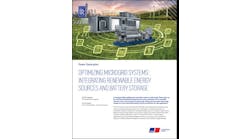As one of the largest minting facilities in the world, the Royal Mint makes more than 3.3 billion coins and blanks annually for the U.K. and some 30 other countries. And now, thanks to a multitechnology microgrid recently launched at the mint’s Llantrisant facility in Wales, its operations will be powered partially by renewables.
“Sustainability is front and center in all we do as a business,” said Inga Doak, head of sustainability at the Royal Mint. “This is another exciting step in the Royal Mint’s sustainability journey, helping us towards our goal of becoming net zero by 2050.”
Infinite Renewables, a Welsh renewable energy company, spearheaded the microgrid project, which it calls an energy center.
Multiple technologies incorporated
The microgrid incorporates a number of different renewable and renewable-ready technologies.
The project includes two Vestas 850-kW “Daffodil” wind turbines designed and built by Infinite Renewables. One of those turbines is located on property adjacent to the mint, along with a 2-MW solar farm that was built by Evo Energy.
AB Energy UK supplied a 2-MW gas fired combined heat and power unit that is hydrogen ready.
The microgrid’s dual chemistry battery energy storage system includes both lead-acid and lithium-ion battery technologies. The containerized energy storage system, which was developed by GS Yuasa, the University of Sheffield and Infinite Renewables, will deliver fast response power from the lithium-ion batteries while the lead-acid batteries will provide longer duration bulk storage capacity.
The microgrid will support other businesses
Infinite Renewables has a long-term power purchase agreement with the Royal Mint but is working on expanding the renewables microgrid network to include other neighboring businesses.
“This low carbon energy center is a trailblazing project that shines a light on the future of local, multitechnology generation and consumption within an industrial community network,” said Andrew Crossman, director at Infinite Renewables.
Crossman added that the project can serve as a “blueprint for both commercial and domestic sustainable energy systems in a low carbon world, protecting business and residential communities against energy market volatility whilst providing energy security for the future.”
Crossman described the business model to Microgrid Knowledge when the project was first announced in 2021.
“Your anchor tenant is a high intensity energy user like the Royal Mint,” he said. “You build the energy center around that anchor tenant but then look to hive off power to other industries within the area, which mitigates the risk of the investment.”
Funded by the European Regional Development Fund, the energy center is part of its Generation Storage Consumption Supply project, which will create up to seven local microgrids across southern and western Wales.
Track news on business and industrial microgrids. Subscribe to the free Microgrid Knowledge newsletter.








